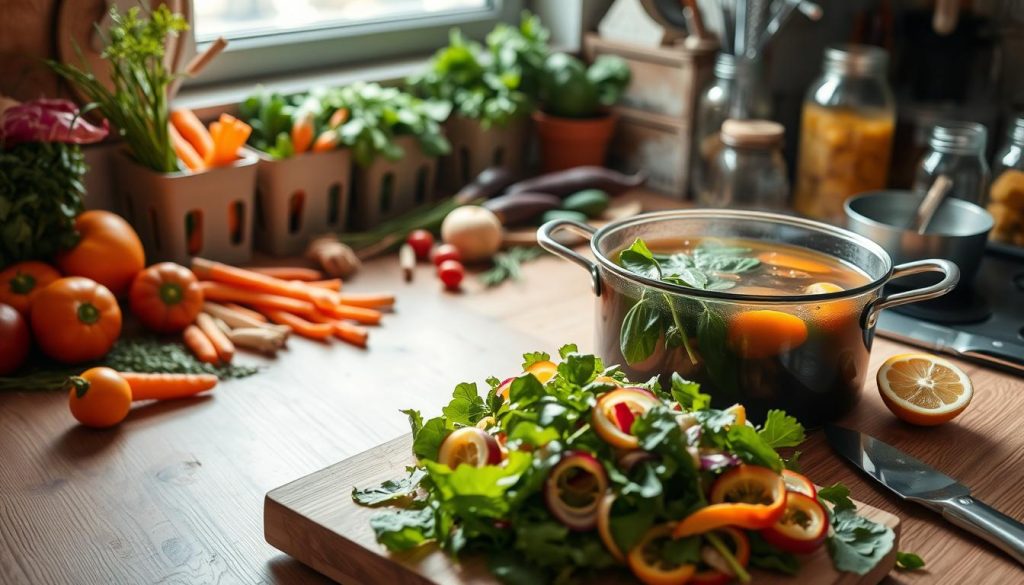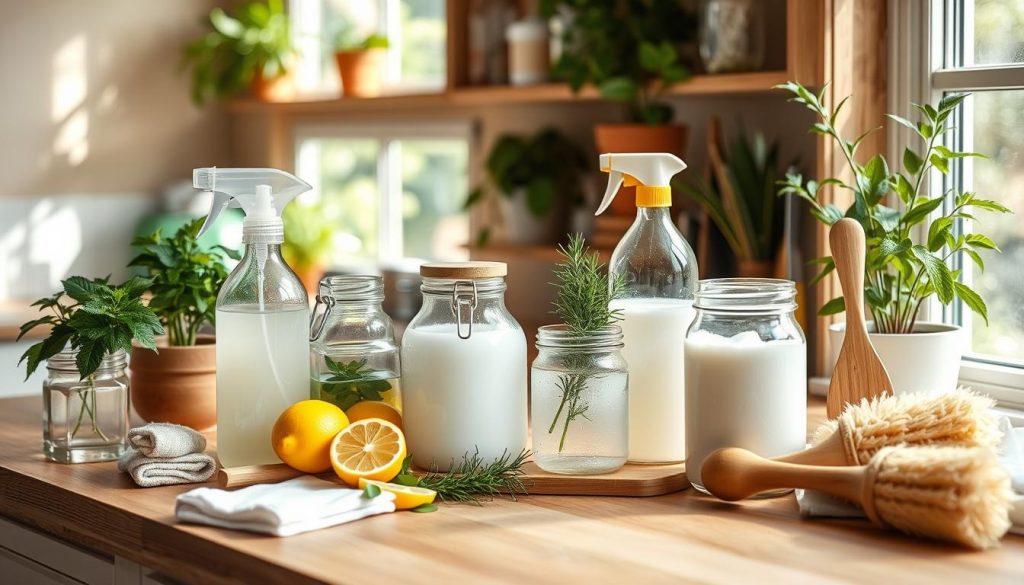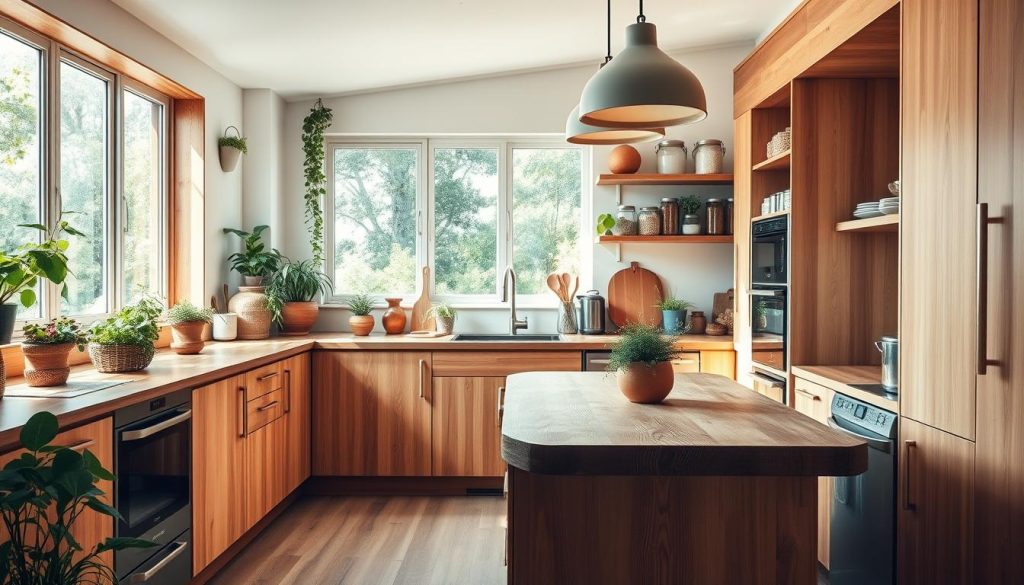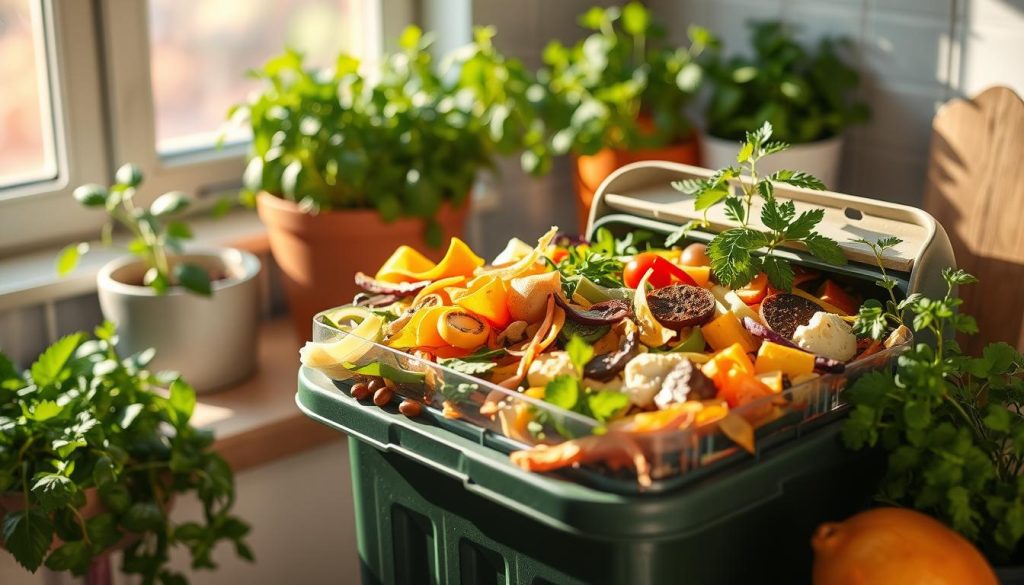Are you ready to make your kitchen more sustainable? Today, being green in the kitchen is key. By using eco-friendly cooking, you can eat well and help the planet. Learn how to make your kitchen a green space with plant-based meals, zero-waste cooking, and seasonal produce.
Key Takeaways
- Discover sustainable cooking ideas for your green kitchen
- Learn eco-friendly techniques to reduce your environmental impact
- Explore delicious plant-based meals and zero-waste cooking
- Embrace the use of organic ingredients and seasonal produce
- Cultivate an environmental consciousness in your kitchen
Why Embrace a Sustainable Green Kitchen?
Choosing a sustainable green kitchen offers many benefits. It saves money, improves food taste, and helps fight climate change. It’s a smart choice that benefits you and the planet.
Money-Saving Benefits
Using energy-efficient appliances and water-saving fixtures can cut your bills. These include Energy Star appliances and low-flow taps. Plus, using natural light and LED bulbs saves even more energy.
Improved Food Flavor
A green kitchen means using fresh ingredients and reducing waste. This choice not only helps the planet but also makes your food taste better. Opting for seasonal, organic produce and “ugly” fruits and veggies adds flavor and variety to your meals.
Fight Climate Change
Every eco-friendly choice in your kitchen helps fight climate change. Energy-efficient appliances and less food waste reduce emissions. Small changes can make a big difference in creating a greener future.
Reduce Food Waste
In a green kitchen, cutting down on food waste is key. Plan meals, use “ugly” produce, and enjoy leftovers. This saves money and reduces environmental impact, helping to lower greenhouse gas emissions.
Easy Swaps for an Eco-Friendly Kitchen
Turning your kitchen into an eco-friendly space is simpler than you think. Just a few swaps can cut down on plastic, waste, and help the planet. Let’s look at some easy steps to make your kitchen greener.
Ditch Plastic Storage Containers
Goodbye to plastic storage containers! Choose glass or stainless steel instead. These are better for your food and last longer. Plus, you’ll feel good about helping the environment.
Reusable Grocery Bags
Trade in flimsy bags for sturdy, reusable ones. You can pick from totes, mesh bags, or cloth bags. This change can save a lot of plastic over time.
Composting Made Simple
Composting is easy and helps your garden. Just set aside a spot for food scraps like peels and eggshells. It turns waste into soil for your plants.
Ditch Bottled Water
Stop buying Bottled Water and use a reusable bottle instead. It saves money and cuts down on plastic waste. Use a water filter for clean, eco-friendly drinking water.
These simple changes can make your kitchen more eco-friendly. Start with one change and see how your kitchen evolves into a green space.
Sustainable Cooking Tips
It’s easier than you think to cook sustainably. A few simple steps can cut down on food waste and use up more ingredients. Let’s dive into some easy ways to make your kitchen greener.
Plan Your Meals
Meal planning is a big help for sustainable cooking. By planning your meals, you can avoid buying too much food that might spoil. Use staples like rice, beans, and greens to save money and reduce waste.
Love Your Leftovers
Don’t throw away extra food! Turn leftovers into new dishes. Use airtight containers or reusable beeswax wraps to keep food fresh and cut down on plastic.
Embrace “Ugly” Produce
Don’t judge a vegetable by its looks. “Ugly” produce is often just as good as the rest. Visit local farmers’ markets to find fresh, seasonal produce and support your community.
Freeze Like a Boss
Freezing food is a key skill for a sustainable kitchen. Freeze leftovers and extra ingredients to enjoy later. Using energy-efficient appliances like induction cooktops can also help reduce your kitchen’s environmental impact.
Zero-Waste Recipes to Try
Reducing food waste in your kitchen is good for the planet and your wallet. Try these tasty recipes that turn kitchen scraps into delicious meals.
Scrappy Vegetable Stock
Don’t throw away veggie ends and peels. Use them to make a tasty homemade broth. Collect veggie trimmings like carrot tops, onion skins, and mushroom stems in a freezer bag. When it’s full, simmer them in water with herbs and spices to make a flavorful Zero-Waste Vegetable Stock.
Leftover Veggie Frittata
Got leftover veggies? Turn them into a tasty Leftover Veggie Frittata. Sauté any leftover veggies, then mix with eggs and bake. It’s a great way to enjoy a zero-waste meal and use up leftovers.
No-Waste Pesto
Pesto can be made with more than just basil. Use carrot tops, beet greens, or other greens for a vibrant No-Waste Pesto. Blend them with nuts, garlic, and olive oil for a tasty sauce. Use it on pasta, sandwiches, or as a dip.

Eco-Friendly Cookware and Utensils
When setting up your green kitchen, choose Sustainable Cookware and Eco-Friendly Utensils. They should be durable and made from eco-friendly materials. Avoid non-stick surfaces and cheap items that harm the environment.
Invest in quality kitchenware that lasts for years. This way, you’ll enjoy cooking without harming the planet.
Some sustainable cooking essentials to consider include:
- Stainless steel pots and pans
- Cast iron skillets and Dutch ovens
- High-quality wooden utensils and cutting boards
- Glass storage containers and bakeware
- Reusable silicone lids and food wraps
These items not only cut down on waste but also cook food better. They’re made from materials that are safe for your health and the planet.
When picking Sustainable Cookware and Eco-Friendly Utensils, look for certifications. Check for PFOA-free, BPA-free, and FSC-certified items. This ensures you’re choosing the best for the environment.
Energy-Efficient Cooking Techniques
Creating a sustainable green kitchen starts with energy-efficient cooking. Simple changes in your cooking habits can save money and help the planet. Here are some easy tips to cook more efficiently.
Skip Preheating
Don’t preheat your oven unless it’s really needed. Preheating can waste a lot of energy. Many dishes cook well without it, so try to avoid this habit.
Maximize Oven Usage
Use your oven wisely. Cook several dishes at once to fill it up. This way, you use the heat more efficiently and save energy.
Proper Pot Size
Choose pots and pans that fit your cooking needs. Big pots waste heat, while the right size keeps it better. This helps you cook more efficiently.
Use Pressure Cookers
Pressure cookers are great for saving energy. They can cook up to 70% faster, using less energy. They’re a smart choice for your meals.
By using these energy-saving cooking methods, you can enjoy tasty, eco-friendly meals. You’ll also save money and help the environment.
Raw and Cold Dishes
To make your kitchen greener, try raw and cold dish options that need little cooking. Salads, chilled soups, and other no-cook meals are tasty, healthy, and save energy. They’re great alternatives to usual cooked dishes.
The blog Green Kitchen Stories is famous for its vegetarian recipes. Their new cookbook is full of beautiful photos and tasty dishes. They have amazing raw dish recipes like Sprout Ceviche, Chocolate and Blackberry Milkshake, and Quinoa & Vegetable Chorizo Salad.
For a tasty cold dish, make the Maple-tossed Beluga Lentil Salad. It serves 4 and has beluga or puy lentils, red rhubarb, strawberries, edamame, red currants, asparagus, and fresh basil. The maple dressing makes it sweet, and you can add feta cheese if you like.
Choosing raw and cold dishes cuts down on energy use. It also keeps more nutrients than cooking does. Using fresh foods lets you make healthy meals without needing lots of heat or prep.
Make Your Own Meals
Embracing Homemade Meals and DIY Cooking is rewarding and sustainable. It lets you control what goes into your food, cut down on processed foods, and save money. Meal Preparation helps you avoid waste, choose fresh, local ingredients, and make meals just how you like them.
The latest cookbook, “Green Kitchen At Home: Quick and Healthy Vegetarian Food for Everyday,” by David Frenkiel and Luise Vindahl, is full of ideas for healthy, eco-friendly meals. It has vegetarian and vegan recipes, plus dishes like Middle Eastern Sweet Potato Wraps for everyone.
- Plan Your Meals: Take the time to plan your weekly or monthly meals, allowing you to utilize ingredients more efficiently and reduce food waste.
- Love Your Leftovers: Get creative with leftovers by repurposing them into new dishes, such as a Leftover Veggie Frittata or a Scrappy Vegetable Stock.
- Embrace “Ugly” Produce: Don’t be afraid to purchase “imperfect” fruits and vegetables, as they are just as nutritious and can help reduce food waste.
- Freeze Like a Boss: Master the art of freezing meals and components, ensuring you always have wholesome, Homemade Meals on hand.
By embracing DIY Cooking and Meal Preparation, you can unlock a world of sustainable, flavorful, and cost-effective Homemade Meals. These meals nourish you and the planet. Start your journey towards a greener, more mindful kitchen today.
Grow Your Own Produce
Make your kitchen more sustainable by growing your own food. You can start with a small herb garden or a big backyard garden. This not only cuts down on carbon emissions but also makes your meals fresher and more rewarding.
In Scarborough, Maine, a 1,500 square foot garden can feed a family of five for a year. Begin small and grow your garden as you learn more. Aim for about 300 square feet of space per person.
- Ensure your garden receives at least six hours of direct sunlight per day.
- Consider building raised beds for better drainage, or plant directly in the ground.
- Focus on crops you and your family enjoy, such as leafy greens, tomatoes, and herbs.
- Use mulch to suppress weeds, retain moisture, and add organic matter to the soil.
- Water your garden about an inch per week, adjusting for your local climate and soil type.
- Practice succession planting to maximize your garden’s productivity and enjoy a continuous harvest.
You can regrow grocery store items like scallions and ginger. You can also grow citrus fruits and avocados. With the right care, your garden will give you plenty of fresh, tasty ingredients for your green kitchen.
DIY Cleaning Products
You can make your own eco-friendly cleaning products for your kitchen. Use common items like white vinegar, baking soda, and essential oils. These natural cleaning solutions are better for the environment than store-bought cleaners.
Homemade cleaners are safer for you and the planet. They’re gentler than commercial cleaners. You can make different types of cleaners at home. But, be careful not to mix dangerous ingredients like ammonia and bleach.
Here are some Homemade Cleaners you can make:
- All-Purpose Cleaner: Mix white distilled vinegar, water, unscented liquid castile soap, and citrus peels.
- Glass Cleaner: Combine white vinegar, water, and a few drops of lemon essential oil.
- Tile and Grout Cleaner: Make a paste with baking soda and water, then scrub with a stiff-bristle brush.
- Stainless Steel Cleaner: Rub the surface with a lemon wedge, then buff with a microfiber cloth.
Using these Natural Cleaning methods keeps your kitchen clean and green. You’ll also avoid harsh chemicals. Enjoy the fresh smells and the knowledge that you’re making your kitchen safer.

Local and Organic Food Sources
Choosing local and organic food makes your kitchen more sustainable. By supporting local farms and joining CSAs, you get fresh, tasty produce. You also help the environment.
Support Local Farms
Buying from local farms means your food travels less. This keeps more nutrients in your food. Friends of the Earth found organic diets cut cancer-causing chemicals by 70% in a week.
Local farming also helps the soil, water, and air. It’s good for the planet.
Join a CSA
Joining a CSA program is a great idea. You buy a share of the farm’s harvest. This way, you get fresh, local food and support green farming.
Shop at Farmers’ Markets
Local Farmer’s Markets are a great place to find sustainable foods. In recent years, more markets have opened. Now, it’s easier to find fresh, delicious produce from local farmers.
Green Kitchen
Creating an Eco-Friendly Kitchen is more than just cooking. It’s about the design and how you use your space. Use energy-saving appliances and sustainable materials. Make your kitchen efficient for cooking and cleaning.
Green cabinets are a big part of a Green Kitchen. Today, all kitchens have green cabinets, from light jade to deep emerald. Glossy finishes are popular, with shades like celery, olive, emerald, and spring green found everywhere.
People love green in kitchens because it connects us to nature. It’s also versatile, working well with many colors. Green kitchens are becoming more common, showing a move towards a greener, more natural look.

An Eco-Friendly Kitchen also means energy-saving appliances and smart storage. Use non-toxic materials too. By focusing on design and function, you can make a kitchen that’s good for the planet and healthy for you.
Bulk Buying and Cooking
Start using Bulk Purchasing, Batch Cooking, and Meal Prepping to make your kitchen more sustainable. Buying in bulk cuts down on packaging waste and saves money in the long run. Cooking big batches and prepping meals ahead of time saves time and energy. This way, you always have healthy, homemade meals ready.
Planning meals in advance reduces kitchen stress and boosts efficiency. Buying staples in bulk saves both time and money. Cooking in large quantities saves time and energy, especially for things like minced meat and tomato sauce. Meal prepping helps manage time better and increases family quality time.
- Reduce food waste by creatively using leftover ingredients to save money and decrease environmental impact.
- Grow herbs at home to provide fresh ingredients for cooking without the need to purchase them.
- Embrace the principles of reducing, reusing, and recycling to lead to more sustainable and eco-friendly kitchen practices.
By adding Bulk Purchasing, Batch Cooking, and Meal Prepping to your kitchen habits, you can make cooking easier, reduce waste, and enjoy a more sustainable and affordable cooking lifestyle.
Waste Not, Want Not
In today’s fast world, it’s easy to overlook the need to reduce food waste. But, adopting a “waste not, want not” mindset can save you money and help the environment. By planning meals, using leftovers, and composting, you can make your kitchen eco-friendly.
Meal Planning
Planning meals ahead can greatly reduce food waste. Spend a few minutes each week planning and making a shopping list. This helps avoid buying too much and ensures you only get what you need. It also helps you use ingredients more efficiently and reduce waste.
Repurpose Leftovers
Don’t let leftovers go to waste! Get creative and turn them into new dishes. Soups, stews, and casseroles are great for using up leftovers. You can also make fried rice, frittatas, or savory pies from them. With a bit of creativity, your kitchen can be waste-free.
Compost Food Scraps
Composting is a simple way to help the environment. Instead of throwing food scraps away, compost them. This turns them into nutrient-rich soil for your garden or plants. It’s a complete cycle of sustainability.

By using these strategies, you’ll save money and reduce your carbon footprint. You’ll also feel good about reducing your kitchen’s environmental impact. Remember, small steps can make a big difference. Start your sustainable journey today.
Energy-Efficient Appliances
When it’s time to upgrade your kitchen appliances, think about getting energy-efficient ones with the Energy Star rating. These appliances, like refrigerators and dishwashers, use less energy and water. This means lower utility costs and a smaller environmental impact.
Energy Star Ratings
The Energy Star label shows an appliance’s energy efficiency. Products with this label meet strict standards from the U.S. Environmental Protection Agency and Department of Energy. They use energy wisely. Choosing Energy Star-rated appliances is a green choice for your kitchen.
Smaller Refrigerators
Smaller refrigerators can save a lot of energy. Big refrigerators need more power to cool more food. So, choosing a compact or mid-size fridge can save energy without losing functionality.
By choosing Energy Star-rated, energy-efficient appliances and smaller fridge sizes, you make your kitchen more eco-friendly. It’s good for the planet and your wallet.
Conclusion
Turning your kitchen into a Sustainable Kitchen is doable. It can save you money, improve your cooking, and help the planet. By following the tips and recipes in this article, you can make your kitchen a green space.
Start with small changes to live more sustainably. Every step you take helps. You can use energy-saving appliances, cook smarter, and plan meals better. These actions will cut down on waste and save you money on bills.
Creating a Sustainable Kitchen is a journey, not just a goal. Enjoy the process and celebrate your successes. Share your journey to inspire others to live more sustainably. Together, we can make our kitchens greener, one change at a time.